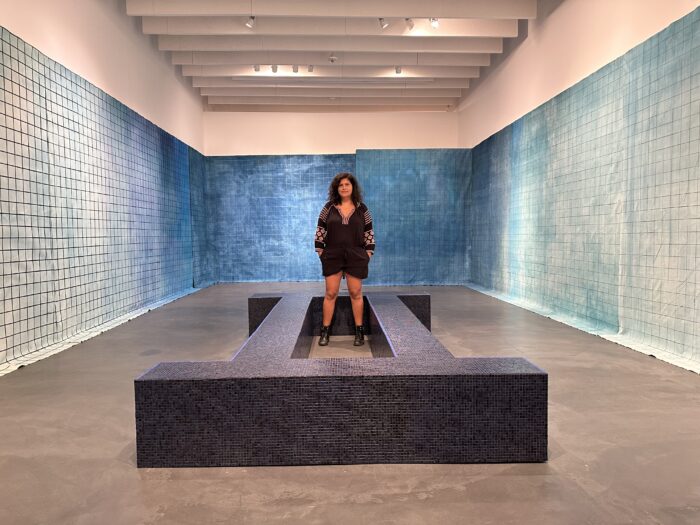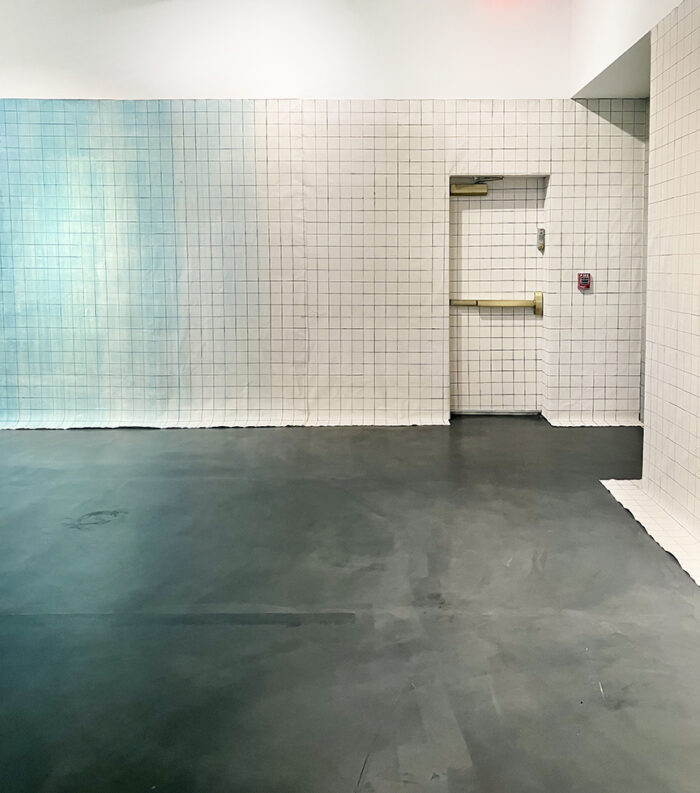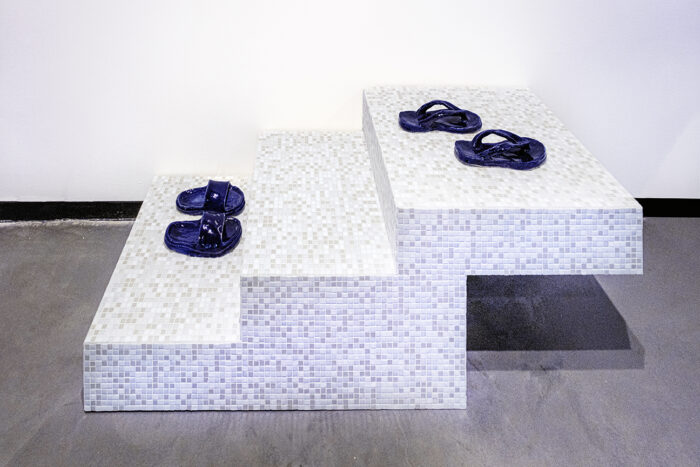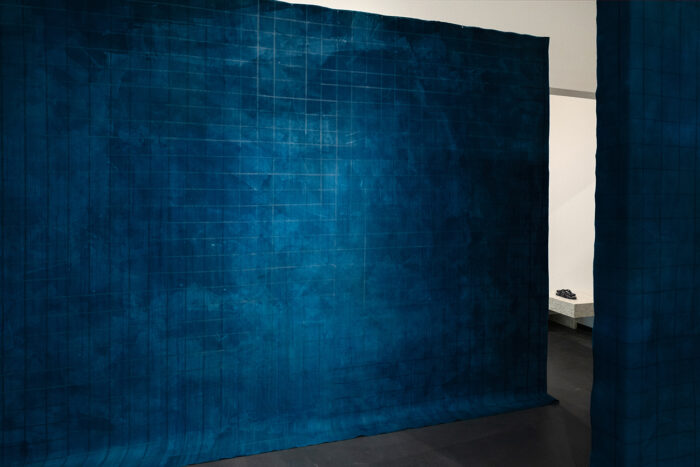
JM: Let’s go back to the beginning and discuss your background in the arts and your artistic journey. Could you please share some insights into your experiences in the arts and the path that led you from Peru to New York?
Cecilia Jurado Chueca: Hello Jamie. I have been working on transition mostly with two topics, first the place that walls have in our lives. Second, the power of water in its multiple forms, the water used as a metaphor for the human spirit, always moving. Since I was an adolescent I used to jump into abandoned houses and photograph their walls trying to make them look less hard, even to look like landscapes through long expositions that made their colors deeper and their perspectives became ambiguous. Those first years were part of my first solo show in 2000 at the Centro de la Fotografía in Peru and later a similar show in New York in 2004. I can say that that solo show in New York was the reason for my extended stay in this city which soon became a full move-in. I fell in love with New York in a very strange way, I just got captivated by its multiculturality and diversity, I felt safe to be whatever I wanted to be and be loved that way. I think that also was the root of some of my following projects that dealt with people traveling for new beginnings that sometimes stay in the streets, in a perennial transition. I, myself, have traveled a lot with my family and my sense of home is elastic, at least. I was making large installations of walls with tiles a few years ago (like the ones of the subway stations), I made them from scratch, and then I broke them, I called them bodies. I have made a variety of ceramic pieces related to first the people who are traveling and their objects and then ceramics about the travel itself like the ongoing series of ceramic airplane windows. If my ceramic pieces were mostly talking about urban life from their own hard materiality, my paintings were talking about the power of nature through representations of water, rivers, waterfalls, oceans, and skies. The color blue has been very present in most of my work as the color of the sky that is on top of us all the time and that changes with the day and the night like our mood and our life changes too. But also, as the color of the ceramics in the Spanish architecture (azulejos) reminds us how colonization is part of our identity and how we deal with this condition, how we transform it.
JM: Glad you stayed in New York. What was the inspiration behind creating the show “Mermaids In The Basement” at Sugar Hill Children’s Museum of Art?
I have been swimming regularly and it has been lately a very important space and time to think. The whole sensation of submerging in water became a necessity. More so now that my life has been changing a lot. I was in Lima-Peru for a year and a half during the Covic pandemic where we were socializing mostly with my close family (my mother, my sister, her kids, my father) and my nuclear family (my son, his father). We were walking just a few blocks around. It felt like returning to the womb. Now that we are back in New York, with a divided family structure, with activities in different parts of the city, I felt that being contained in this small space, the pool, was a must. Washing, cleaning, healing, holding your breath many times and surviving. As was telling you in the first question, I have worked with water, painting, sculpting, and photographing rivers and oceans (constantly in awe of how water is always moving and passing through the smallest gaps). At the same time, I have been creating walls, with tiles similar to the ones in the subway station. While I was swimming last year, I realized that I was in a place that had both: the water and the walls. So then I wanted to create a space where people can have the sensation of going underground and through the painted walls think that they are inside of a pool that is half full on one side, and half empty on the other. I also wanted to address the transformation I was / am passing, as well as the changes of other women who have left their hometowns for new beginnings. With the curator of the show, Blanca de la Torre, we invited immigrant women (we call them the mermaids) to sing songs of longing. So this installation wasn’t going to be just about my story but many stories.

JM: How did you come to select the music for the show, specifically the captivating song by Coral Campopiano that beautifully portrays the theme of change?
I have been working on and off with music in my installations, because of how moving a voice and lyrics can be. One song I used before and is in Mermaids in the Basement as well is a popular Peruvian song about a person that leaves Ayacucho “Adios Pueblo de Ayacucho”, a town that had been hit very hard in the past with terrorism, military oppression, and social disparity. The song says how much this person misses her town but how her exit is urgent. Last year I also worked on an exhibition with Blanca de la Torre, the curator of the show at Sugar Hill Museum, in a town in Honduras, Cerdeño, where the ocean is taking little by little the houses and restaurants by the shore. Over there a woman who had left the town also sang a song remembering it. So that song is also part of the ones that are in the show Mermaids in the Basement.
I wanted to connect the moment that one enters the pool installation, it submerges into a place full of other tales through the songs, with these Mermaids that sing their stories. With Blanca, we started to talk with different women we knew had left their homes to ask if they wanted to sing. Most of them singers, some of them not. Sara Van, Alessandra Pinasco, Feli Ordoñez, Claudia Ramos Guzman and Kristine Guzman, Rebecca Nelson, Eva Andronikidou, Marcela Roque de Churay, Blanca Guevara, Milagros Guerrero, Coral Campopiano, and Maria Margarita Reyes.
The song sung by Coral Campopiano was written by Chilean musician Julio Numhauser in exile in 1982 and massively popularized by Argentinian singer Mercedes Sosa in 1984. It was very important in the context of serious changes in Latin America, from totalitarian governments to democracies, and vice versa. But it could be listened to right now and be as current. Coral was my first roommate when I came in 2003, so we have a special connection, and many shared first moments in the city. She was the only one who asked me to give her some suggestions. I wanted her to participate because her voice is captivating (as you said). So I asked around and my friend Martin Touzon, from Argentina, helped me with some. Coral immediately chose Todo Cambia, as the song spoke to her journey, and sang it with a lot of passion. She was the last person to give me her song but it was so worth the wait as it paired very well with my pool that goes from full to empty. From dark deep blue to whites. When it is empty it looks like a metro station, where many people are in transit. The idea of the change was and is the visual core of the exhibition.
JM: What do you want a viewer to walk away with after seeing “Mermaids in the Basement”?
To be moved somehow. Maybe this is a short answer and very ambitious. But yes, it can be a brief sensation or a deeper feeling or thought. I had spent hundreds of hours drawing the tiles and painting those canvas walls knowing that any intention to create a sensation of being submerged without the water itself would be an attempt. But that’s part of the nature of our practice. I do think that the energy of those hundreds of hours of work translates sensorially into the public, in an implicit silent way. In contrast with the music, the voices, and tales of the mermaids that can be heard even if you walk in for 10 seconds. I will be very happy with someone feeling something, to be true.

JM: In the sculpture titled “The Water Understands (my son and I),” the imagery I perceive involves your son’s flip-flops trailing behind your own as both pairs enter the pool. Does this artwork signify an invitation for your son to join the realm of mermaids and follow in your footsteps into the world of art?
That’s an interesting question. My son is very close to me (emotionally and physically), and that is partly why I portray myself with him -through the two pairs of ceramic flip-flops, his and mine-. In my personal life, I walk a lot with him, I take him to his school, to his music classes, to his soccer classes, to the pool, etc. So this sculpture, The Water Understands, of two people getting ready to jump, or that have already jumped (into the pool or else) is a family story, like the story of so many women that are also singing in the installation. In the museum, it doesn’t say that is my son and me, so it could be any two people (although the small sandals can be seen as kids’ size). There is always someone coming after, the next to transform…

JM: I had no prior knowledge that the original mermaids were depicted as a combination of half-bird and half-woman. How does this concept intersect with the artwork and overall theme of the exhibition?
I didn’t know about it while preparing the show. Blanca de la Torre, the curator, did research about the history of various myths of mermaids for her essay and found one that depicted first them as half-birds so they can fly to find a female goddess, as the assignment wasn’t fulfilled, they were punished to live in the ocean, or in an underworld. I think this fabulation coincides with the journey of the women singing in my installation who travel to live a new life, in a new place. In my installation, there is a mosaic sculpture in the middle that functions as an island, a boat, a bench, with the shape of two black lines of an Olympic pool united. Inside there is a hole where my body (and most bodies) fit extending arms and legs. I think we are all navigating on an ongoing basis, on our ships that are sometimes shared and sometimes not.
